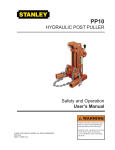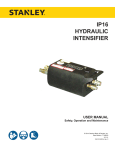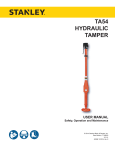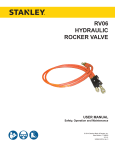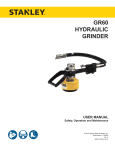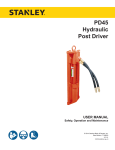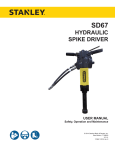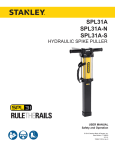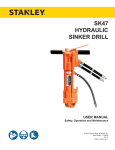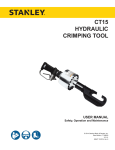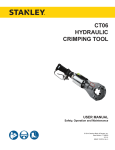Download PP10 User Manual - Stanley Hydraulic Tools
Transcript
PP10 HYDRAULIC POST PULLER USER MANUAL Safety, Operation and Maintenance © 2014 Stanley Black & Decker, Inc. New Britain, CT 06053 U.S.A. 59020 9/2014 Ver. 7 TABLE OF CONTENTS SAFETY SYMBOLS...................................................................................................................................................4 SAFETY PRECAUTIONS...........................................................................................................................................5 TOOL STICKERS & TAGS.........................................................................................................................................6 HOSE TYPES.............................................................................................................................................................7 HOSE RECOMMENDATIONS...................................................................................................................................8 FIGURE 1. TYPICAL HOSE CONNECTIONS........................................................................................................8 HTMA REQUIREMENTS............................................................................................................................................9 OPERATION.............................................................................................................................................................10 TOOL PROTECTION & CARE................................................................................................................................. 11 TROUBLESHOOTING.............................................................................................................................................12 SPECIFICATIONS....................................................................................................................................................13 ACCESSORIES.......................................................................................................................................................13 PP10 PARTS ILLUSTRATION.................................................................................................................................14 PP10 PARTS LIST...................................................................................................................................................15 IMPORTANT To fill out a Product Warranty Validation form, and for information on your warranty, visit Stanleyhydraulics.com and select the Company tab, Warranty. (NOTE: The warranty Validation record must be submitted to validate the warranty). SERVICING: This manual contains safety, operation, and routine maintenance instructions. Stanley Hydraulic Tools recommends that servicing of hydraulic tools, other than routine maintenance, must be performed by an authorized and certified dealer. Please read the following warning. WARNING SERIOUS INJURY OR DEATH COULD RESULT FROM THE IMPROPER REPAIR OR SERVICE OF THIS TOOL. REPAIRS AND / OR SERVICE TO THIS TOOL MUST ONLY BE DONE BY AN AUTHORIZED AND CERTIFIED DEALER. For the nearest authorized and certified dealer, call Stanley Hydraulic Tools at the number listed on the back of this manual and ask for a Customer Service Representative. PP10 User Manual ◄ 3 SAFETY SYMBOLS Safety symbols and signal words, as shown below, are used to emphasize all operator, maintenance and repair actions which, if not strictly followed, could result in a life-threatening situation, bodily injury or damage to equipment. This is the safety alert symbol. It is used to alert you to potential personal injury hazards. Obey all safety messages that follow this symbol to avoid possible injury or death. DANGER This safety alert and signal word indicate an imminently hazardous situation which, if not avoided, will result in death or serious injury. WARNING This safety alert and signal word indicate a potentially hazardous situation which, if not avoided, could result in death or serious injury. CAUTION This safety alert and signal word indicate a potentially hazardous situation which, if not avoided, could result in death or serious injury. CAUTION This signal word indicates a potentially hazardous situation which, if not avoided, may result in property damage. NOTICE This signal word indicates a situation which, if not avoided, will result in damage to the equipment. IMPORTANT This signal word indicates a situation which, if not avoided, may result in damage to the equipment. Always observe safety symbols. They are included for your safety and for the protection of the tool. LOCAL SAFETY REGULATIONS Enter any local safety regulations here. Keep these instructions in an area accessible to the operator and maintenance personnel. 4 ► PP10 User Manual SAFETY PRECAUTIONS Tool operators and maintenance personnel must always comply with the safety precautions given in this manual and on the stickers and tags attached to the tool and hose. These safety precautions are given for your safety. Review them carefully before operating the tool and before performing general maintenance or repairs. Supervising personnel should develop additional precautions relating to the specific work area and local safety regulations. If so, place the added precautions in the space provided in this manual. The models PP10 Hydraulic Post Puller will provide safe and dependable service if operated in accordance with the instructions given in this manual. Read and understand this manual and any stickers and tags attached to the PP10 before operation. Failure to do so could result in personal injury or equipment damage. • Operator must start in a work area without bystanders. The operator must be familiar with all prohibited work areas such as excessive slopes and dangerous terrain conditions. • Establish a training program for all operators to ensure safe operation. • Do not operate the tool unless thoroughly trained or under the supervision of an instructor. • Always wear safety equipment such as goggles, ear and head protection, and safety shoes at all times when operating the tool. • Do not inspect or clean the tool while the hydraulic power source is connected. Accidental engagement of the tool can cause serious injury. • Always connect hoses to the tool hose couplers before energizing the hydraulic power source. Be sure all hose connections are tight. • Do not operate the tool at oil temperatures above 140 °F/60 °C. Operation at higher temperatures can cause higher than normal temperatures at the tool which can result in operator discomfort. • Do not operate a damaged, improperly adjusted, or incompletely assembled tool. • Stay clear of all moving parts. • Never wear loose clothing that can get entangled in the working parts of the tool. • To avoid personal injury or equipment damage, all tool repair, maintenance and service must only be performed by authorized and properly trained personnel. • System pressure hose must always be connected to the tool IN or “P” port and system return hose must be connected to the tool OUT or “T” port. Reversing connections or reversing flow to the tool can result in severe personal injury. • Never use tools near energized transmission lines. Know the location of buried or covered services before starting your work. • Do not overreach. Maintain proper footing and balance at all times. PP10 User Manual ◄ 5 TOOL STICKERS & TAGS CAUTION 4-9 GPM/15-34 LPM DO NOT EXCEED 2000 PSI/140 BAR DO NOT EXCEED SPECIFIED FLOW OR PRESSURE. USE CLOSEDCENTER TOOL ON CLOSED-CENTER SYSTEM. USE OPEN-CENTER TOOL ON OPEN-CENTER SYSTEM. CORRECTLY CONNECT HOSES TO TOOL 'IN' AND 'OUT' PORTS. IMPROPER HANDLING, USE OR MAINTENANCE OF TOOL COULD RESULT IN A LEAK, BURST, OR OTHER TOOL FAILURE. CONTACT AT A LEAK OR BURST CAN CAUSE OIL INJECTION INTO THE BODY. FAILURE TO OBSERVE THESE PRECAUTIONS CAN RESULT IN SERIOUS PERSONAL INJURY. 16599 05152 Logo/Address Decal 16599 GPM Sticker 4–9 2000 Psi WARNING PINCH POINT STAY CLEAR OF ALL MOVING PARTS 17572 Pinch Point Warning Sticker 35210 Warning Sticker 17573 PP10 Name Tag NOTE: THE INFORMATION LISTED ON THE STICKERS SHOWN, MUST BE LEGIBLE AT ALL TIMES. REPLACE DECALS IF THEY BECOME WORN OR DAMAGED. REPLACEMENTS ARE AVAILABLE FROM YOUR LOCAL STANLEY DISTRIBUTOR. The safety tag (P/N 15875) at right is attached to the tool when shipped from the factory. Read and understand the safety instructions listed on this tag before removal. We suggest you retain this tag and attach it to the tool when not in use. D A N G E R 1. FAILURE TO USE HYDRAULIC HOSE LABELED AND CERTIFIED AS NON-CONDUCTIVE WHEN USING HYDRAULIC TOOLS ON OR NEAR ELECTRICAL LINES MAY RESULT IN DEATH OR SERIOUS INJURY. BEFORE USING HOSE LABELED AND CERTIFIED AS NONCONDUCTIVE ON OR NEAR ELECTRIC LINES BE SURE THE HOSE IS MAINTAINED AS NON-CONDUCTIVE. THE HOSE SHOULD BE REGULARLY TESTED FOR ELECTRIC CURRENT LEAKAGE IN ACCORDANCE WITH YOUR SAFETY DEPARTMENT INSTRUCTIONS. 2. A HYDRAULIC LEAK OR BURST MAY CAUSE OIL INJECTION INTO THE BODY OR CAUSE OTHER SEVERE PERSONAL INJURY. A. DO NOT EXCEED SPECIFIED FLOW AND PRESSURE FOR THIS TOOL. EXCESS FLOW OR PRESSURE MAY CAUSE A LEAK OR BURST. B. DO NOT EXCEED RATED WORKING PRESSURE OF HYDRAULIC HOSE USED WITH THIS TOOL. EXCESS PRESSURE MAY CAUSE A LEAK OR BURST. C. CHECK TOOL HOSE COUPLERS AND CONNECTORS DAILY FOR LEAKS. DO NOT FEEL FOR LEAKS WITH YOUR HANDS. CONTACT WITH A LEAK MAY RESULT IN SEVERE PERSONAL INJURY. D A N G E R D. DO NOT LIFT OR CARRY TOOL BY THE HOSES. DO NOT ABUSE HOSE. DO NOT USE KINKED, TORN OR DAMAGED HOSE. 3. MAKE SURE HYDRAULIC HOSES ARE PROPERLY CONNECTED TO THE TOOL BEFORE PRESSURING SYSTEM. SYSTEM PRESSURE HOSE MUST ALWAYS BE CONNECTED TO TOOL “IN” PORT. SYSTEM RETURN HOSE MUST ALWAYS BE CONNECTED TO TOOL “OUT” PORT. REVERSING CONNECTIONS MAY CAUSE REVERSE TOOL OPERATION WHICH CAN RESULT IN SEVERE PERSONAL INJURY. 4. DO NOT CONNECT OPEN-CENTER TOOLS TO CLOSEDCENTER HYDRAULIC SYSTEMS. THIS MAY RESULT IN LOSS OF OTHER HYDRAULIC FUNCTIONS POWERED BY THE SAME SYSTEM AND/OR SEVERE PERSONAL INJURY. 5. BYSTANDERS MAY BE INJURED IN YOUR WORK AREA. KEEP BYSTANDERS CLEAR OF YOUR WORK AREA. 6. WEAR HEARING, EYE, FOOT, HAND AND HEAD PROTECTION. 7. TO AVOID PERSONAL INJURY OR EQUIPMENT DAMAGE, ALL TOOL REPAIR MAINTENANCE AND SERVICE MUST ONLY BE PERFORMED BY AUTHORIZED AND PROPERLY TRAINED PERSONNEL. I M P O R T A N T I M P O R T A N T READ OPERATION MANUAL AND SAFETY INSTRUCTIONS FOR THIS TOOL BEFORE USING IT. READ OPERATION MANUAL AND SAFETY INSTRUCTIONS FOR THIS TOOL BEFORE USING IT. USE ONLY PARTS AND REPAIR PROCEDURES APPROVED BY STANLEY AND DESCRIBED IN THE OPERATION MANUAL. USE ONLY PARTS AND REPAIR PROCEDURES APPROVED BY STANLEY AND DESCRIBED IN THE OPERATION MANUAL. TAG TO BE REMOVED ONLY BY TOOL OPERATOR. TAG TO BE REMOVED ONLY BY TOOL OPERATOR. SEE OTHER SIDE SEE OTHER SIDE SAFETY TAG P/N 15875 (Shown smaller then actual size) 6 ► PP10 User Manual HOSE TYPES The rated working pressure of the hydraulic hose must be equal to or higher than the relief valve setting on the hydraulic system. There are three types of hydraulic hose that meet this requirement and are authorized for use with Stanley Hydraulic Tools. They are: Certified non-conductive — constructed of thermoplastic or synthetic rubber inner tube, synthetic fiber braid reinforcement, and weather resistant thermoplastic or synthetic rubber cover. Hose labeled certified nonconductive is the only hose authorized for use near electrical conductors. Wire-braided (conductive) — constructed of synthetic rubber inner tube, single or double wire braid reinforcement, and weather resistant synthetic rubber cover. This hose is conductive and must never be used near electrical conductors. Fabric-braided (not certified or labeled non-conductive) — constructed of thermoplastic or synthetic rubber inner tube, synthetic fiber braid reinforcement, and weather resistant thermoplastic or synthetic rubber cover. This hose is not certified non-conductive and must never be used near electrical conductors. HOSE SAFETY TAGS To help ensure your safety, the following DANGER tags are attached to all hose purchased from Stanley Hydraulic Tools. DO NOT REMOVE THESE TAGS. If the information on a tag is illegible because of wear or damage, replace the tag immediately. A new tag may be obtained from your Stanley Distributor. D A N G E R D A N G E R 1. FAILURE TO USE HYDRAULIC HOSE LABELED AND CERTIFIED AS NON-CONDUCTIVE WHEN USING HYDRAULIC TOOLS ON OR NEAR ELECTRIC LINES MAY RESULT IN DEATH OR SERIOUS INJURY. FOR PROPER AND SAFE OPERATION MAKE SURE THAT YOU HAVE BEEN PROPERLY TRAINED IN CORRECT PROCEDURES REQUIRED FOR WORK ON OR AROUND ELECTRIC LINES. 2. BEFORE USING HYDRAULIC HOSE LABELED AND CERTIFIED AS NON-CONDUCTIVE ON OR NEAR ELECTRIC LINES. WIPE THE ENTIRE LENGTH OF THE HOSE AND FITTING WITH A CLEAN DRY ABSORBENT CLOTH TO REMOVE DIRT AND MOISTURE AND TEST HOSE FOR MAXIMUM ALLOWABLE CURRENT LEAKAGE IN ACCORDANCE WITH SAFETY DEPARTMENT INSTRUCTIONS. 3. DO NOT EXCEED HOSE WORKING PRESSURE OR ABUSE HOSE. IMPROPER USE OR HANDLING OF HOSE COULD RESULT IN BURST OR OTHER HOSE FAILURE. KEEP HOSE AS FAR AWAY AS POSSIBLE FROM BODY AND DO NOT PERMIT DIRECT CONTACT DURING USE. CONTACT AT THE BURST CAN CAUSE BODILY INJECTION AND SEVERE PERSONAL INJURY. 4. HANDLE AND ROUTE HOSE CAREFULLY TO AVOID KINKING, ABRASION, CUTTING, OR CONTACT WITH HIGH TEMPERATURE SURFACES. DO NOT USE IF KINKED. DO NOT USE HOSE TO PULL OR LIFT TOOLS, POWER UNITS, ETC. 5. CHECK ENTIRE HOSE FOR CUTS CRACKS LEAKS ABRASIONS, BULGES, OR DAMAGE TO COUPLINGS IF ANY OF THESE CONDITIONS EXIST, REPLACE THE HOSE IMMEDIATELY. NEVER USE TAPE OR ANY DEVICE TO ATTEMPT TO MEND THE HOSE. 6. AFTER EACH USE STORE IN A CLEAN DRY AREA. SEE OTHER SIDE SIDE 1 SEE OTHER SIDE (Shown smaller than actual size) DO NOT REMOVE THIS TAG DO NOT REMOVE THIS TAG THE TAG SHOWN BELOW IS ATTACHED TO “CERTIFIED NON-CONDUCTIVE” HOSE SIDE 2 D A N G E R D A N G E R 1. DO NOT USE THIS HYDRAULIC HOSE ON OR NEAR ELECTRIC LINES. THIS HOSE IS NOT LABELED OR CERTIFIED AS NON-CONDUCTIVE. USING THIS HOSE ON OR NEAR ELECTRICAL LINES MAY RESULT IN DEATH OR SERIOUS INJURY. 5. CHECK ENTIRE HOSE FOR CUTS CRACKS LEAKS ABRASIONS, BULGES, OR DAMAGE TO COUPLINGS IF ANY OF THESE CONDITIONS EXIST, REPLACE THE HOSE IMMEDIATELY. NEVER USE TAPE OR ANY DEVICE TO ATTEMPT TO MEND THE HOSE. 2. FOR PROPER AND SAFE OPERATION MAKE SURE THAT YOU HAVE BEEN PROPERLY TRAINED IN CORRECT PROCEDURES REQUIRED FOR WORK ON OR AROUND ELECTRIC LINES. 6. AFTER EACH USE STORE IN A CLEAN DRY AREA. 3. DO NOT EXCEED HOSE WORKING PRESSURE OR ABUSE HOSE. IMPROPER USE OR HANDLING OF HOSE COULD RESULT IN BURST OR OTHER HOSE FAILURE. KEEP HOSE AS FAR AWAY AS POSSIBLE FROM BODY AND DO NOT PERMIT DIRECT CONTACT DURING USE. CONTACT AT THE BURST CAN CAUSE BODILY INJECTION AND SEVERE PERSONAL INJURY. 4. HANDLE AND ROUTE HOSE CAREFULLY TO AVOID KINKING, CUTTING, OR CONTACT WITH HIGH TEMPERATURE SURFACES. DO NOT USE IF KINKED. DO NOT USE HOSE TO PULL OR LIFT TOOLS, POWER UNITS, ETC. DO NOT REMOVE THIS TAG DO NOT REMOVE THIS TAG THE TAG SHOWN BELOW IS ATTACHED TO “CONDUCTIVE” HOSE. SEE OTHER SIDE SEE OTHER SIDE SIDE 1 SIDE 2 (Shown smaller than actual size) PP10 User Manual ◄ 7 8 ► PP10 User Manual All hydraulic hose must meet or exceed specifications as set forth by SAE J517. All hydraulic hose must have at least a rated minimum working pressure equal to the maximum hydraulic system relief valve setting. This chart is intended to be used for hydraulic tool applications only based on Stanley Hydraulic Tools tool operating requirements and should not be used for any other applications. The chart to the right shows recommended minimum hose diameters for various hose lengths based on gallons per minute (gpm)/ liters per minute (lpm). These recommendations are intended to keep return line pressure (back pressure) to a minimum acceptable level to ensure maximum tool performance. Tool to Hydraulic Circuit Hose Recommendations 15-34 MM Inside Diameter INCH USE (Press/Return) PSI up to 10 up to 3 3/8 10 Both 2250 49-60 13-16 FLOW >>> RETURN <<< FLOW PRESSURE 26-100 up to 25 100-200 51-100 up to 50 100-300 51-100 up to 50 26-100 up to 25 8-30 up to 8 30-60 15-30 up to 15 30-90 15-30 up to 15 7.5-30 up to 7.5 Figure 1. Typical Hose Connections 49-60 13-16 38-49 10-13 38-49 19-40 5-10.5 10-13 19-40 5-10.5 38-49 19-40 5-10.5 10-13 15-23 15-23 4-6 3/8 10 19 19 25.4 3/4 1 16 5/8 3/4 19 25.4 1 19 3/4 3/4 16 16 5/8 16 19 5/8 3/4 5/8 16 13 13 5/8 1/2 1/2 Both Return Pressure Return Pressure Return Pressure Return Pressure Both Return Pressure Both Both Both 2500 2500 2500 2500 2500 2500 2500 2500 2500 2500 2500 2500 2500 2500 2500 175 175 175 175 175 175 175 175 175 175 175 175 175 175 175 155 BAR Min. Working Pressure Certified Non-Conductive Hose - Fiber Braid - for Utility Bucket Trucks METERS Hose Lengths FEET Conductive Hose - Wire Braid or Fiber Braid -DO NOT USE NEAR ELECTRICAL CONDUCTORS 4-6 4-9 LPM Oil Flow GPM HOSE RECOMMENDATIONS HTMA / EHTMA REQUIREMENTS HTMA / EHTMA REQUIREMENTS HTMA HYDRAULIC SYSTEM REQUIREMENTS TYPE I Nominal Operating Pressure (at the power supply outlet) 4-6 gpm (15-23 lpm) 1500 psi (103 bar) TOOL TYPE TYPE II TYPE RR 7-9 gpm (26-34 lpm) 1500 psi (103 bar) 9-10.5 gpm (34-40 lpm) 1500 psi (103 bar) System relief valve setting (at the power supply outlet) 2100-2250 psi (145-155 bar) 2100-2250 psi (145-155 bar) 2200-2300 psi (152-159 bar) 2100-2250 psi (145-155 bar) Maximum back pressure (at tool end of the return hose) 250 psi (17 bar) 250 psi (17 bar) 250 psi (17 bar) 250 psi (17 bar) Measured at a max. fluid viscosity of: (at min. operating temperature) 400 ssu* 400 ssu* 400 ssu* 400 ssu* (82 centistokes) (82 centistokes) (82 centistokes) (82 centistokes) Temperature: Sufficient heat rejection capacity to limit max. fluid temperature to: (at max. expected ambient temperature) 140° F (60° C) Flow Range 140° F (60° C) 140° F (60° C) TYPE III 11-13 gpm (42-49 lpm) 1500 psi (103 bar) 140° F (60° C) 3 hp 5 hp 6 hp 7 hp Min. cooling capacity at a temperature (2.24 kW) (3.73 kW) (5.22 kW) (4.47 kW) difference of between ambient and fluid 40° F 40° F 40° F 40° F temps (22° C) (22° C) (22° C) (22° C) NOTE: Do not operate the tool at oil temperatures above 140° F (60° C). Operation at higher temperatures can cause operator discomfort at the tool. Filter Min. full-flow filtration Sized for flow of at least: (For cold temp. startup and max. dirt-holding capacity) 25 microns 30 gpm (114 lpm) Hydraulic fluid Petroleum based (premium grade, anti-wear, non-conductive) Viscosity (at min. and max. operating temps) 100-400 ssu* 25 microns 30 gpm (114 lpm) 25 microns 30 gpm (114 lpm) 100-400 ssu* 100-400 ssu* (20-82 centistokes) 25 microns 30 gpm (114 lpm) 100-400 ssu* NOTE: When choosing hydraulic fluid, the expected oil temperature extremes that will be experienced in service determine the most suitable temperature viscosity characteristics. Hydraulic fluids with a viscosity index over 140 will meet the requirements over a wide range of operating temperatures. *SSU = Saybolt Seconds Universal EHTMA HYDRAULIC SYSTEM REQUIREMENTS CLASSIFICATION B C D Nominal Operating Pressure (at the power supply outlet) 3.5-4.3 gpm (13.5-16.5 lpm) 1870 psi (129 bar) 4.7-5.8 gpm (18-22 lpm) 1500 psi (103 bar) 7.1-8.7 gpm (27-33 lpm) 1500 psi (103 bar) 9.5-11.6 gpm (36-44 lpm) 1500 psi (103 bar) 11.8-14.5 gpm (45-55 lpm) 1500 psi (103 bar) System relief valve setting (at the power supply outlet) 2495 psi (172 bar) 2000 psi (138 bar) 2000 psi (138 bar) 2000 psi (138 bar) 2000 psi (138 bar) Flow Range NOTE: These are general hydraulic system requirements. See tool specification page for tool specific requirements PP10 User Manual ◄ 9 OPERATION PRE-OPERATION PROCEDURES TOOL OPERATION CHECK HYDRAULIC POWER SOURCE 1. Observe all safety precautions. 1. Using a calibrated flowmeter and pressure gauge, check that the hydraulic power source develops a flow of 3–9 gpm/11–34 lpm at 2000 psi/140 bar. 2. For flanged posts, position the base weldment on a flat surface with the post engaged in the jaws of the tool. 2. Make certain the hydraulic power source is equipped with a relief valve set to open at 2100–2250 psi/145– 155 bar minimum. 3. For solid or square posts, position the base weldment on a flat surface and wrap a chain around the post. Place the chain in the slots on the post puller frame. CHECK TOOL 1. There should be no signs of leaks. 2. The tool should be clean, with all fittings and fasteners tight. CONNECT HOSES 1. Wipe all hose couplers with a clean lint-free cloth before making connections. 2. Connect the hoses from the hydraulic power source to the tool fittings or quick disconnects. It is a good practice to connect the return hose first and disconnect it last to minimize or avoid trapped pressure within the tool. 3. Observe flow indicators stamped on hose couplers to be sure that oil will flow in the proper direction. The female coupler is the inlet coupler. NOTE: The pressure increase in uncoupled hoses left in the sun may result in making them difficult to connect. When possible, connect the free ends of operating hoses together. 4. Observe all safety precautions. 5. Move the hydraulic circuit control valve to the ON position to operate the tool. 10 ► PP10 User Manual 4. Actuate the control lever from the NEUTRAL position to the UP position until the post raises approximately eight inches. 5. Move the control lever from the UP position past the NEUTRAL position to the DOWN position. This releases the jaws (or chain) from the post and lowers the lift frame weldment down to the base weldment (bottom of post). 6. Repeat Steps one through five until the post is fully removed. COLD WEATHER OPERATION If the post puller is to be used during cold weather, preheat the hydraulic fluid at low engine speed. When using the normally recommended fluids, fluid temperature should be at or above 50 °F/10°C (400 ssu/82 centistokes) before use. Damage to the hydraulic system or post puller can result from use with fluid that is too viscous or thick. TOOL PROTECTION & CARE NOTICE In addition to the Safety Precautions found in this manual, observe the following for equipment protection and care. • Make sure all couplers are wiped clean before connection. Use only lint-free cloths. • Never connect or disconnect couplers or port connections with hydraulic pressure in the hose. • The hydraulic circuit control valve must be in the OFF position when coupling or uncoupling hydraulic tools. Failure to do so may result in damage to the quick couplers and cause overheating of the hydraulic system. • Make certain that the recommended relief valves are installed in the pressure side of the system. • • Always store the tool in a clean dry space, safe from damage or pilferage. Always check high-pressure couplers for leaks and damage before operating the system at maximum rated pressure. • • Always replace hoses, couplings and other parts with replacement parts recommended by Stanley Hydraulic Tools. Supply hoses to the intensifier must have a minimum working pressure rating of 2500 psi/175 bar. Check fastener tightness often and before each use daily. • All hoses must have an oil resistant inner surface and an abrasion resistant outer surface. Whenever near electrical conductors, use clean hoses labeled and certified non-conductive. • Always keep critical tool markings, such as warning stickers and tags legible. • Do not exceed the rated limits or use the tool for applications beyond its design capacity. • Tool repair should be performed by experienced personnel only. PP10 User Manual ◄ 11 TROUBLESHOOTING If symptoms of poor performance develop, the following chart can be used as a guide to correct the problem. When diagnosing faults in operation of the Post Puller, always check that the hydraulic power source is supplying the correct hydraulic flow and pressure to the post puller as listed in the table. Use a flowmeter known to be accurate. Check the flow with the hydraulic oil temperature at least 80 °F/27 °C. PROBLEM Post puller does not run. Post puller does not pull effectively. Post puller operates slow. Post puller gets hot. CAUSE SOLUTION Power unit not functioning. Check power unit for proper flow and pressure (3–9 gpm/11–34 lpm, 2000 psi/140 bar). Coupler or hoses blocked. Remove restriction. Mechanical failure of lift cylinder assembly. Disassemble post puller and inspect for damaged parts. Power unit not functioning. Check power unit for proper pressure (2000 psi/140 bar). Couplers or hoses blocked. Remove restriction. Low gpm supply from power unit. Check power source for proper flow (3–9 gpm/11–34 lpm). Coupler or hoses blocked. Remove restriction. Relief valve set too low. Adjust relief valve to 2100–2250 psi/145–155 bar. Hot fluid going through tool. Check power unit. Make sure the flow rate is not too high causing part of the fluid to go through the relief valve. Provide cooler to maintain proper fluid temperature (140 °F/60 °C max). Check relief valve setting. Eliminate flow control devices. 12 ► PP10 User Manual SPECIFICATIONS Capacity (Lift per Stroke)............................................................................................................................ 8 in./20 cm Pulling Force.....................................................................................................................................9800 lbs/4450 kg Weight....................................................................................................................................................70 lbs/31.8 kg Flow Range.................................................................................................................................. 3–9 gpm/11–34 lpm Pressure Range................................................................................................................................ 2000 psi/140 bar Porting........................................................................................................................... 3/8 NPT Female Pipe Thread Connect Size.............................................................................................................................. 90° Elbow 3/8 NPTM Height (Retracted)............................................................................................................................... 18-3/4 in/48 cm Length................................................................................................................................................. 12 3/4 in/32 cm Width...................................................................................................................................................... 14 in/35.5 cm System Type............................................................................................................................................ Open Center NOTE: Weights, dimensions, and operating specifications listed are subject to change without notice. Where specifications are critical to your application, please consult the factory. ACCESSORIES Chain Assembly..................................................................................................................................................17529 PP10 User Manual ◄ 13 14 ► PP10 User Manual 26 47 46 PP10100A ONLY NOTE: Item # 23 has changed from a 45° elbow to a straight Adapter P/N00946 in November 2011. PP10 PARTS ILLUSTRATION PP10 PARTS LIST ITEM PART NO. QTY DESCRIPTION ITEM PART NO. QTY DESCRIPTION 1 17533 1 T-BAR 41 05152 2 STANLEY STICKER 2 04985 2 SPRING WASHER 42 17572 2 PINCH POINT WARNING STICKER 3 17553 2 SHOULDER SCREW, 3/4 × 3/4 HEX SOCKET HEAD 43 17573 1 NAME TAG 44 19220 1 TFE RING * 45 19221 1 O-RING * 46 35149 1 POST (PP10100A ONLY) 47 35212 1 HITCH PIN ASSY (PP10100A ONLY) 03971 1 COUPLER SET (NOT SHOWN) 35210 1 WARNING DECAL (NOT SHOWN) 02324 1 CAP & PLUG, 1/2 (PP10100D ONLY) 03288 1 CAP & PLUG 3/8 (PP10100D ONLY) 19219 1 SEAL KIT (* DENOTES PART IN KIT) 4 00166 1 RETAINING RING, 1.850 HEAVY DUTY (INTERNAL) 5 17526 1 SEAL RETAINER 6 03127 1 ROD WIPER * 7 09642 1 WASHER 8 09647 1 ROD SEAL * 9 09790 2 O-RING, 2-1/4 × 2-1/2 × 1/8 * 10 17546 1 PISTON ROD 11 17536 1 CYLINDER 12 17552 1 PISTON 13 17554 2 WEAR RING * 14 04984 1 ELASTIC STOP NUT, 3/4-16 HEX 15 17550 1 LIFT FRAME WELDMENT 16 371500 8 ELASTIC STOP NUT, 1/2-13 HEX 17 01751 2 O-RING 3/8 × 9/16 × 3/32 * 18 06736 4 CAPSCREW, 5/16-18 × 2-1/4 HEX HEAD 19 01752 1 ADAPTER FITTING 20 35518 1 VALVE ASSEMBLY 21 18514 1 GUARD WELDMENT 22 35213 2 SWIVEL, HYDRAULIC INC #956P6-P6 23 00946 1 ADAPTER 3/8 NPT MALE/3/8 TUBE 24 72801 1 HOSE ASSEMBLY (SEE NOTE 1) 25 17537 4 TIE ROD 26 17538 1 BASE WELDMENT 35134 1 BASE WELDMENT (PP10100A ONLY) 27 01532 1 ELBOW, 90°-6 SAE/-6 TUBE 28 17545 1 CYLINDER BASE 29 17549 1 CYLINDER BEARING 30 17544 1 ADAPTER BLOCK 31 17529 1 CHAIN ASSY (ACCESSORY ITEM) 32 17559 2 WASHER, 7/8 NARROW TYPE B 33 17534 2 MODIFIED CAPSCREW 34 17540 2 SHOULDER SCREW 35 17543 1 JAW, RH (PP10100) 33452 1 JAW, RH (PP10100A) 17542 1 JAW, LH (PP10100) 33453 1 JAW, LH (PP10100A) 37 17541 1 PIVOT BLOCK 38 00569 2 CAPSCREW, 5/16-18 × 1 HEX HD 39 03031 2 LOCKWASHER, 5/16 40 16599 1 GPM STICKER 36 NOTE 1: If you have an older PP10 built prior to November 2011 and you are replacing item # 24 Hose Assembly you will also need to replace item # 23 Adapter. Their is a Hose Assy Service Kit (P/N-72802) available that includes the Hose Assy 72801 and adapter 00946. The Hose Assy 17558 is no longer available. PP10 User Manual ◄ 15 Stanley Hydraulic Tools 3810 SE Naef Road Milwaukie, Oregon 97267-5698 USA (503) 659-5660 / Fax (503) 652-1780 www.stanleyhydraulics.com
















